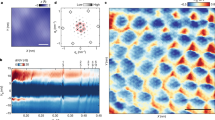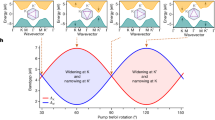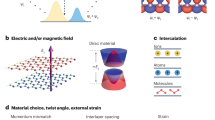Abstract
The design of stacks of layered materials in which adjacent layers interact by van der Waals forces1 has enabled the combination of various two-dimensional crystals with different electrical, optical and mechanical properties as well as the emergence of novel physical phenomena and device functionality2,3,4,5,6,7,8. Here, we report photoinduced doping in van der Waals heterostructures consisting of graphene and boron nitride layers. It enables flexible and repeatable writing and erasing of charge doping in graphene with visible light. We demonstrate that this photoinduced doping maintains the high carrier mobility of the graphene/boron nitride heterostructure, thus resembling the modulation doping technique used in semiconductor heterojunctions, and can be used to generate spatially varying doping profiles such as p–n junctions. We show that this photoinduced doping arises from microscopically coupled optical and electrical responses of graphene/boron nitride heterostructures, including optical excitation of defect transitions in boron nitride, electrical transport in graphene, and charge transfer between boron nitride and graphene.
This is a preview of subscription content, access via your institution
Access options
Subscribe to this journal
Receive 12 print issues and online access
$259.00 per year
only $21.58 per issue
Buy this article
- Purchase on Springer Link
- Instant access to full article PDF
Prices may be subject to local taxes which are calculated during checkout




Similar content being viewed by others
References
Geim, A. K. & Grigorieva, I. V. Van der Waals heterostructures. Nature 499, 419–425 (2013).
Li, G. et al. Observation of Van Hove singularities in twisted graphene layers. Nature Phys. 6, 109–113 (2010).
Xue, J. et al. Scanning tunnelling microscopy and spectroscopy of ultra-flat graphene on hexagonal boron nitride. Nature Mater. 10, 282–285 (2011).
Decker, R. G. et al. Local electronic properties of graphene on a BN substrate via scanning tunneling microscopy. Nano Lett. 11, 2291–2295 (2011).
Yankowitz, M. et al. Emergence of superlattice Dirac points in graphene on hexagonal boron nitride. Nature Phys. 8, 382–386 (2012).
Ponomarenko, L. A. et al. Cloning of Dirac fermions in graphene superlattices. Nature 497, 594–597 (2013).
Dean, C. R. et al. Hofstadter's butterfly and the fractal quantum Hall effect in moiré superlattices. Nature 497, 598–602 (2013).
Hunt, B. et al. Massive Dirac fermions and Hofstadter butterfly in a van der Waals heterostructure. Science 340, 1427–1430 (2013).
Britnell, L. et al. Strong light–matter interactions in heterostructures of atomically thin films. Science 340, 1311–1314 (2013).
Dean, C. R. et al. Boron nitride substrates for high-quality graphene electronics. Nature Nano 5, 722–726 (2010).
Zomer, P. J., Dash, S. P., Tombros, N. & van Wees, B. J. A transfer technique for high mobility graphene devices on commercially available hexagonal boron nitride. Appl. Phys. Lett. 99, 232104 (2011).
Kim, Y. D. et al. Focused-laser-enabled p–n junctions in graphene field-effect transistors. ACS Nano 7, 5850–5857 (2013).
Tiberj, A. et al. Reversible optical doping of graphene. Sci. Rep. 3, 2355 (2013).
Novoselov, K. S. et al. Electric field effect in atomically thin carbon films. Science 306, 666–669 (2004).
Zhang, Y. B., Tan, Y. W., Stormer, H. L. & Kim, P. Experimental observation of the quantum Hall effect and Berry's phase in graphene. Nature 438, 201–204 (2005).
Dingle, R., Stormer, H. L., Gossard, A. C. & Wiegmann, W. Electron mobilities in modulation-doped semiconductor heterojunction super-lattices. Appl. Phys. Lett. 33, 665–667 (1978).
Pfeiffer, L., West, K. W., Stormer, H. L. & Baldwin, K. W. Electron mobilities exceeding 107 cm2/V s in modulation-doped GaAs. Appl. Phys. Lett. 55, 1888–1890 (1989).
Schedin, F. et al. Detection of individual gas molecules adsorbed on graphene. Nature Mater. 6, 652–655 (2007).
Chen, J. H. et al. Charged-impurity scattering in graphene. Nature Phys. 4, 377–381 (2008).
Pi, K. et al. Electronic doping and scattering by transition metals on graphene. Phys. Rev. B 80, 075406 (2009).
Huard, B. et al. Transport measurements across a tunable potential barrier in graphene. Phys. Rev. Lett. 98, 236803 (2007).
Williams, J. R., DiCarlo, L. & Marcus, C. M. Quantum Hall effect in a gate-controlled p–n junction of graphene. Science 317, 638–641 (2007).
Ozyilmaz, B. et al. Electronic transport and quantum Hall effect in bipolar graphene p–n–p junctions. Phys. Rev. Lett. 99, 166804 (2007).
Lohmann, T., von Klitzing, K. & Smet, J. H. Four-terminal magneto-transport in graphene p–n junctions created by spatially selective doping. Nano Lett. 9, 1973–1979 (2009).
Museur, L. et al. Exciton optical transitions in a hexagonal boron nitride single crystal. Phys. Status Solidi RRL 5, 214–216 (2011).
Hwang, E. H., Adam, S. & Das Sarma, S. Carrier transport in two-dimensional graphene layers. Phys. Rev. Lett. 98, 186806 (2007).
Yan, J. & Fuhrer, M. S. Correlated charged impurity scattering in graphene. Phys. Rev. Lett. 107, 206601 (2011).
Attaccalite, C., Bockstedte, M., Marini, A., Rubio, A. & Wirtz, L. Coupling of excitons and defect states in boron-nitride nanostructures. Phys. Rev. B 83, 144115 (2011).
Yang, W. et al. Epitaxial growth of single-domain graphene on hexagonal boron nitride. Nature Mater. 12, 792–797 (2013).
Acknowledgements
The authors thank P. Jarillo-Herrero and N. Gabor for stimulating discussions and B. Standley for help with data acquisition software. Graphene synthesis, device fabrication and optical measurements were supported by the Office of Naval Research (award N00014-13-1-0464). Electrical measurements and theoretical analysis of this work were mainly supported by the Office of Basic Energy Science, Department of Energy (contract no. DE-SC0003949, Early Career Award; DE-AC02-05CH11231, Materials Science Division). F.W. acknowledges support from a David and Lucile Packard fellowship. J.V.J. acknowledges support from the UC President's Postdoctoral fellowship.
Author information
Authors and Affiliations
Contributions
F.W. and L.J. conceived the experiment. L.J. and J.V.J. carried out optical and electronic measurements. J.V.J., E.H., S.K., C.N., H.T and W.Y. contributed to sample fabrication, K.W. and T.T. synthesized the h-BN samples, F.W., J.V.J. and L.J. performed data analysis and theoretical analysis. F.W., L.J. and J.V.J. co-wrote the manuscript. All authors discussed the results and commented on the paper.
Corresponding author
Ethics declarations
Competing interests
The authors declare no competing financial interests.
Supplementary information
Supplementary information
Supplementary information (PDF 1394 kb)
Rights and permissions
About this article
Cite this article
Ju, L., Velasco, J., Huang, E. et al. Photoinduced doping in heterostructures of graphene and boron nitride. Nature Nanotech 9, 348–352 (2014). https://doi.org/10.1038/nnano.2014.60
Received:
Accepted:
Published:
Issue Date:
DOI: https://doi.org/10.1038/nnano.2014.60
This article is cited by
-
Intrinsic 1\({T}^{{\prime} }\) phase induced in atomically thin 2H-MoTe2 by a single terahertz pulse
Nature Communications (2023)
-
A reconfigurable transistor and memory based on a two-dimensional heterostructure and photoinduced trapping
Nature Electronics (2023)
-
Recent developments in CVD growth and applications of 2D transition metal dichalcogenides
Frontiers of Physics (2023)
-
Spontaneous-polarization-induced photovoltaic effect in rhombohedrally stacked MoS2
Nature Photonics (2022)
-
Ultrafast intrinsic optical-to-electrical conversion dynamics in a graphene photodetector
Nature Photonics (2022)



